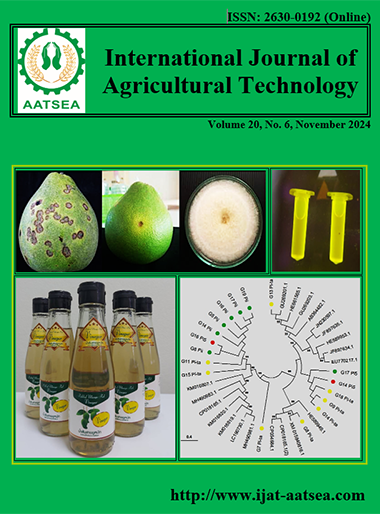Differential quantities of carbon quantum dots incorporated feed on the growth and biochemical traits of Zebrafish (Danio rerio)
Main Article Content
Abstract
Carbon quantum dots possess excellent hydrophilicity and cell permeability, making them very suitable for water-based and bio-related applications. However, there is a lack of research on the utilization of carbon quantum dots in fish feed. The results of this investigation showed that carbon quantum dots have high adsorption peaks at 355 nm in the UV-visible absorption spectra. SEM image was observed at the wavelength range from 13.77 to 13.69. EDAX spectrum showed three peaks and was located on the spectrum between 0.1 KeV and 3 KeV. FT-IR spectral observation was at a wavelength range from 4000 to 500 cm-1. The condition factor of Zebrafish exhibited an increase in all the experimental feeds as compared to the original condition. The consumption of feed, the efficiency of converting feed into growth, growth rate, percentage of growth, rate of growth relative to body size, assimilation of nutrients, metabolism, and efficiency of gross and net growth were all higher in F4 when it contained 1.5 ml of synthesized carbon quantum dots (1.39±0.28, 0.53±0.16, 0.05±0.005, 20.96±4.98, 1.36±0.28, 1.32±0.26, 5.85±2.14, and 6.08±1.30). The results conclude that 1.5 ml of carbon quantum dots incorporated in feed enhanced Zebrafish’s growth and biochemical traits
Article Details

This work is licensed under a Creative Commons Attribution-NonCommercial-NoDerivatives 4.0 International License.
References
Abinaya, K., Rajkishore, S. K., Lakshmanan, A., Anandham, R., Dhananchezhiyan, P. and Praghadeesh, M. (2021). Synthesis and characterization of carbon dots from coconut shell by optimizing the hydrothermal carbonization process. Journal of Applied and Natural Science, 13:1151-1157.
Baker, S. N. and Baker, G. A. (2010). Luminescent carbon nanodots: emergent nanolights. Angew Chemie International Edition, England, 49:6726-6744.
Dager, A., Uchida, T. and Maekawa, T. (2019). Synthesis and characterization of Mono-disperse Carbon Quantum Dots from Fennel Seeds: Photoluminescence analysis using Machine Learning. Science Reports, 9:14004.
Ghoreishi, S. M., Najdian, A., Yadegari, S., Seyedhamzeh, M., Etemadzade, M., Mirzaei, M., Hadadian, S., Alikhani, Z. and Ardestani, M. S. (2020). The Use of Carbon Quantum Dot as Alternative for Stannous Chloride Application in Radiopharmaceutical Kits. Contrast Media and Molecular Imaging. doi.org/10.1155/2020/4742158
Guo, Y., Zhang, L., Cao, F. and Leng, Y. (2016). Thermal treatment of hair for the synthesis of sustainable carbon quantum dots and the applications for sensing Hg2+. Science Reports, 6:35795.
Havrdova, M., Hola, K., Skopalik, J., Tomankova, K., Petr, M., Cepe, K., Polakova, K., Tucek, J., Bourlinos, A. B. and Zboril, R. (2016). Toxicity of carbon dots − Effect of surface functionalization on the cell viability, reactive oxygen species generation and cell cycle. Carbon, 99:238-248.
InnocenzI, P., Malfatti, L., Marras, S., Carbonaro, C. M., Granozzi, G., Ludmerczki, R., Calvillo, L., Mura, S., Mandity, I., Garroni, S., Carraro, M. and Senes. N. (2019). Carbon dots from citric acid and its intermediates formed by thermal decomposition. Chemistry- A European Journal. 10.1002/chem.201902497.
Iwińska, Z. and Pietrusiewicz, P. (2020). Synthesis of Carbon Quantum Dots from Food Products by Hydrothermal Carbonization Method. IOP Conference Series: Materials Science Engineering, 877:012010.
Jlassi, K., Eid, K. and Sliem, M. H. (2020). Rational synthesis, characterization, and application of environmentally friendly (polymer–carbon dot) hybrid composite film for fast and efficient UV-assisted Cd2+ removal from water. Environmental Science Europe, 32:12.
Kang, Y-F., Li, Y-H., Fang, Y-W., Xu, Y., Wei, X-M. and Yin, X-B. (2015). Carbon quantum dots for zebrafish fluorescence imaging. Science Reports, 5:1-12.
Rani, U. A., Ng, L. Y., Ng, C. Y. and Mahmoudi, E. (2020). A review of carbon quantum dots and their applications in wastewater treatment. Advances in Colloid Interface Science, 278:102124.
Roy, P., Chen, P. C., Periasamy, A. P., Chen, Y. N. and Chang, H. T. (2015). Photoluminescent carbon nanodots: synthesis, physicochemical properties and analytical applications. Materials Today, 18:447-458.
Singh, I., Arora, R., Dhiman, H. and Pahwa, R. (2018). Carbon quantum dots: Synthesis, characterization and biomedical applications. Turkish Journal of Pharmaceutical Science, 15:219.
Sun, M., Qu, S., Ji, W., Jing, P., Li, D., Qin, L., Cao, J., Zhang, H., Zhao, J. and Shen, D. (2015). Towards efficient photoinduced charge separation in carbon nanodots and TiO2 composites in the visible region. Physical Chemistry, 17:7966-71.
Sutanto, H., Alkian, N., Romanda, W. L., Lewa., Marhaendrajaya. and Triadyaksa, P. (2020). High green-emission carbon dots and its optical properties: Microwave power effect. AIP Advances, 10:055008.
Wang, Y., Meng, H., Jia, M., Zhang, Y., Li, H. and Feng, L. (2016). Intraparticle FRET of Mn(ii)-doped carbon dots and its application in discrimination of volatile organic compounds. Nanoscale, 8:17190-17195.
Wang, R., Lu, K. Q., Tang, Z. R. and Xu, Y. J. (2017). Recent progress in carbon quantum dots: synthesis, properties and applications in photocatalysis.Journal of Materials Chemistry, A5:3717-3734.
Zhang, B., Liu., C. Y. and Liu, Y. (2010). A novel one‐step approach to synthesize fluorescent carbon nanoparticles. European Journal of Inorganic Chemistry, 28:4411- 4414.


